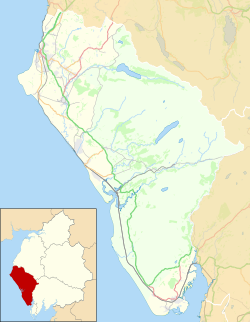| Lowca | |
|---|---|
 The main street of Lowca village | |
Location within Cumbria | |
| Population | 888 (2011) [1] |
| OS grid reference | NX976220 |
| Civil parish |
|
| Unitary authority | |
| Ceremonial county | |
| Region | |
| Country | England |
| Sovereign state | United Kingdom |
| Post town | WHITEHAVEN |
| Postcode district | CA28 |
| Dialling code | 01946 |
| Police | Cumbria |
| Fire | Cumbria |
| Ambulance | North West |
| UK Parliament | |
Lowca is a village and civil parish in the English county of Cumbria, just to the north of the village of Moresby. It had a population of 773 in 2001, [2] increasing to 888 at the 2011 Census. [1]
Contents
It was formerly a mining area but is now noted for its wind farm.
Lowca looks out over the Solway Firth to the west. The village used to stand next to a huge black slag heap called Pit Bank until the slag heap was redeveloped in the 1980s, along with a new road leading directly through Lowca from the A595.
Lowca has its own community school, previously known as Lowca Primary School, and rugby team.

